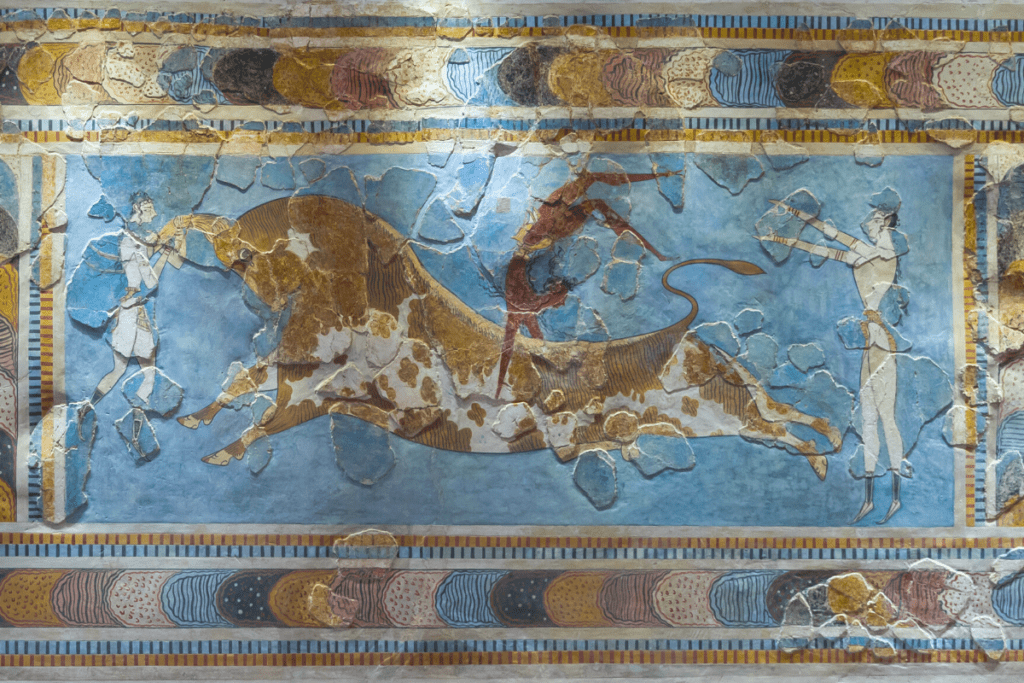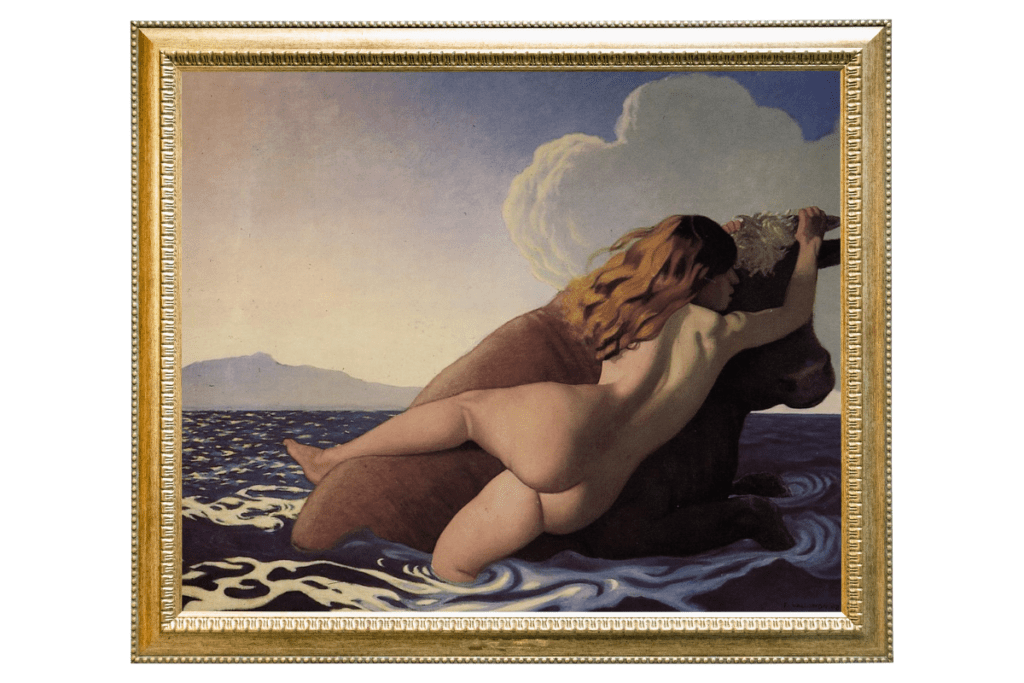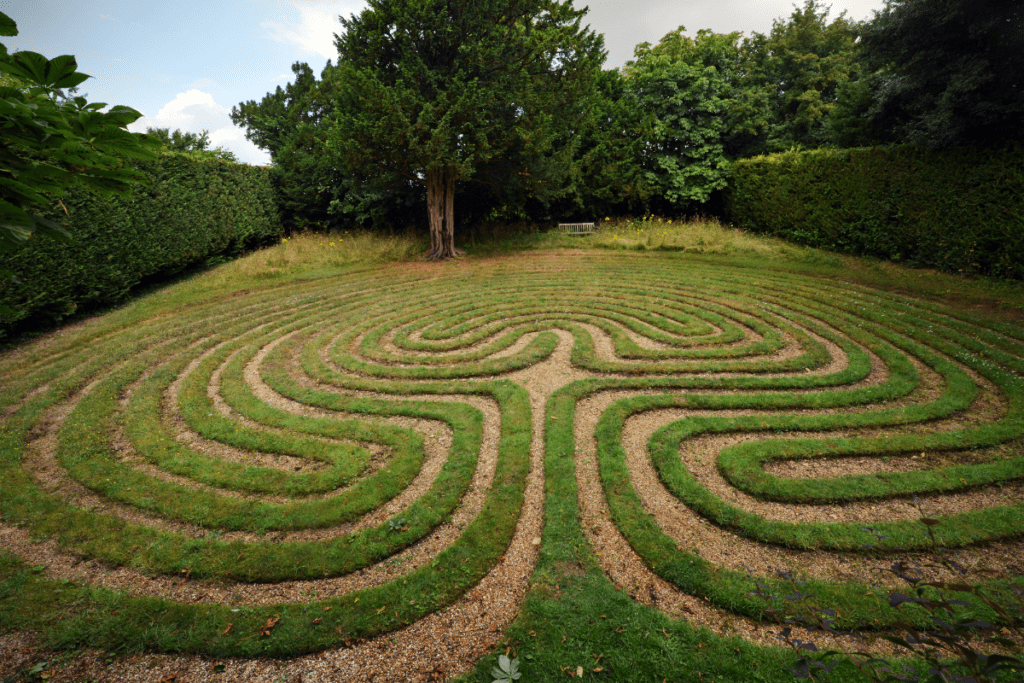Years before I saw a photograph of the Minoan Snake Goddess, I learned stories about Crete in Greek literature. One of these stories was about the Minotaur, one of the Ancient Greek world’s most fascinating and enduring mythical creatures. To the Greeks, the Minotaur was a monster slain by one of their heroes, but his story may contain hints of Minoan religion and modern psychospiritual and sexual symbolism.
The Minoans were a Bronze Age Aegean civilisation on Crete and other Aegean islands from about 3500 BCE to 1100 BCE. I first read about Minos, the Cretan King of Knossos, in Homer’s Iliad, written in the 8th century BCE, about 350 years after the collapse of the Minoan civilisation. To get to know the Minotaur and other Cretan figures, we need to peel back the layers of Greek mythology.
The birth and death of the Minotaur
Like with most myths, there are variations, but one famous story of the Minotaur goes like this.
To confirm his right to rule over his brothers, King Minos prayed to Poseidon to send him a white bull as a sign of the sea god’s favour. Poseidon sent Minos the bull, which the king was supposed to sacrifice. However, King Minos thought the bull was too beautiful and offered Poseidon another bull as a substitute. Enraged, Poseidon had Aphrodite curse Minos’ wife, Pasiphaë, causing her to lust for the splendid white bull.
Pasiphaë went to the craftsman Daedalus and asked him to help her mate with the bull. He constructed a hollow wooden cow with real cow skin. She climbed into it and mated with the bull. Pasiphaë became pregnant and gave birth to a half-man, half-bull creature. She named him Asterion.
Pasiphaë nursed the infant Minotaur, but he became ferocious as he grew older. Following advice from the oracle at Delphi, Minos had Daedalus construct the giant Labyrinth beneath the palace to contain the Minotaur.
At some point, King Minos’ son Androgeus was killed in Athens. In retribution, the Athenians sent 14 young noble citizens (seven young men and seven maidens), chosen by lots, every seven or nine years as sacrificial victims to be devoured by the Minotaur. The Athenian prince Theseus volunteered to go and slay the monster.
When Theseus arrived on Crete, Ariadne, King Minos’ daughter, fell in love with him. In charge of the Labyrinth, Ariadne gave Theseus instructions on how to get to the heart of it and a ball of thread so he could retrace his steps. He made his way to the heart of the Labyrinth, killed the Minotaur, and followed the string to find his way out. Ariadne and Theseus then eloped (and he later abandoned her).
Asterion, the starry one

Although called the Minotaur, the “Bull of Minos”, his name is Asterion, which means “starry” and hints at his divine origins. Bulls have been identified with the constellation of Taurus since the Neolithic period and were a central theme in the Minoan civilisation. In the Early Bronze Age, Taurus marked the point of the spring equinox.
Some scholars believe that the Minotaur was a god associated with the stars, while others say he represented the sun god of the Cretans. It’s worth noting here that the Minotaur’s mother, Pasiphaë, whose name means “light”, was the daughter of the sun god Helios and is thought to have been a Cretan solar goddess originally.
Károly Kerényi, a Hungarian scholar of classical studies, associated Asterion with Dionysus and with the Mistress of the Labyrinth, thought to be Ariadne. She is widely accepted as having Minoan origins. After Theseus abandoned her, Ariadne became the consort of Dionysus. She was also associated with the Underworld, represented by the Labyrinth; the Romans identified her with Proserpina, the bride of Liber, the Romanised form of Dionysus.
I wonder if the relationship between Ariadne and the Minotaur/Dionysus is similar to that of Ishtar and Tammuz, in which the gods are dying-and-rising deities associated with vegetation. The Minoans have a lot in common with the Near East.
The Greek myth of Theseus and the Minotaur may preserve fragments of history. The young Athenian nobles sacrificed to the Minotaur may be a long echo of the Minoan bull cult, which may have involved bull-leaping, animal sacrifice, and priests wearing masks or horns. Theseus’ slaying of the Minotaur could represent the historical end of Minoan dominance in the Aegean. A labyrinth was never found in Knossos, but the palace is so vast and complex that it could have easily been mistaken for one.
Violence and the lust for beauty

Sir Arthur Evans excavated Knossos from 1900 until 1930. His work aroused widespread public interest and made a vivid impression on the popular imagination. In Cretan art, writers, artists, and thinkers of the early twentieth century found a vehicle for exploring modern concerns such as war and changing sexual politics. They saw a culture of elegance and sophistication in Minoan Crete with an undercurrent of sexuality and animal violence.
European interest in the bull begins years before the Minotaur and far from Crete. It begins with Zeus, who, disguised as a stunning white bull, abducted the Phoenician princess Europa, and swept her away to Crete. Europa had three sons by Zeus; one of them was Minos.
In the 1920s, the abduction of Europa was a popular motif in Europe, which is named after the goddess. Artists interpreted the abduction of Europa not as rape but as a sexual awakening, the arousal of animal instincts, and the fulfilment of sexual desire.
In the 1930s, the Minotaur emerged as a complex figure. As a monster that demanded the flesh and blood of young Athenian citizens, the Minotaur (or King Minos) was a stand-in for Franco, Mussolini, and Hitler. He also represented human alienation; the Labyrinth was the dark, chaotic world. Artists such as André Masson and Pablo Picasso were obsessed with the Minotaur.
The bestial force of the unconscious

The Minotaur and the Labyrinth get a lot of Jungian analysis. The Minotaur represents our primal fears of the unconscious, the unknown, and the parts of ourselves that we resist–the Shadow of the self. The Labyrinth is the place we enter to meet our Shadow. It is the dark, disorienting, winding path towards what C.G. Jung called individuation, towards wholeness. It’s not enough to find the centre. Individuation requires integration, so we must find our way out of the Labyrinth.
In psychotherapy, Ariadne’s thread represents the therapeutic relationship between the psychotherapist and the client. Like Ariadne’s thread, the therapist supports the client and guides them safely back into the world. For people exploring their Shadow on their own, we must become Ariadne. She represents intuition, connection, and the ability to remain rooted as we journey into the dark heart of the Labyrinth.
Labyrinths have different purposes around the world. Labyrinths on the floors of medieval cathedrals served as substitutes for pilgrimage paths. In coastal areas of Scandinavia, people used them to trap malevolent trolls and winds to ensure safe fishing expeditions. For many today, walking a labyrinth is a contemplative practice. Jung called the journey “a special initiation into the mysterious world of the collective unconscious”.
The Minotaur as a liberator
The stories about Crete, the art they inspired, and the interpretation of that art all come down to us through a patriarchal, and often misogynist, lens. Nietzsche, Freud, Frazer, Picasso, and others took ancient myths and held them up as a mirror to modern consciousness. They also used myths to project their own psyches. Picasso identified with the Minotaur, which he viewed as a creature of huge physical strength and raging, virile masculinity. This is not surprising for a man who regarded women as “goddesses and doormats” and “machines for suffering”; the mistreatment of women was a vital part of Picasso’s creative process.
Myth is the poetic condensation of history. These Cretan myths centre on women’s experiences, yet we rarely hear from women. The once-goddesses Europa, Pasiphaë, and Ariadne are reduced to supporting characters who exist to advance the plot of the soulful male hero. The sacred bull is locked away and eventually killed.
Theseus is called the Liberator for killing the Minotaur and ending the practice of sacrificing Athenian youths, but I think the Minotaur can be the liberator. As a solar figure, he illuminates. As a shamanic figure associated with the Labyrinth, he is a powerful and protective guide through our inner darkness.


1 thought on “The Minotaur: Beauty, violence, and the forbidden”